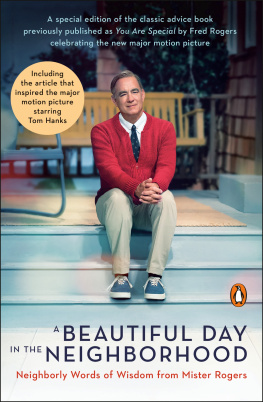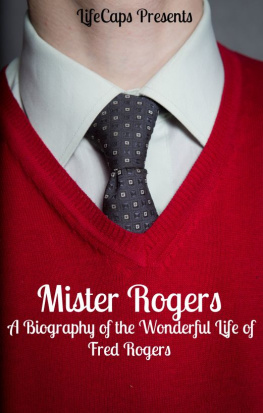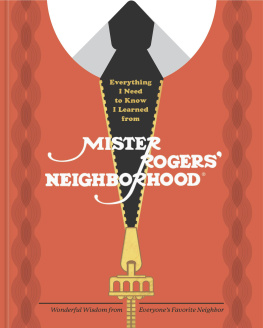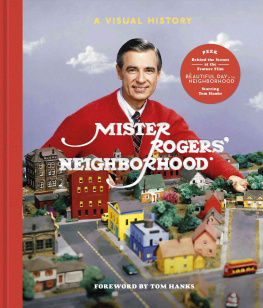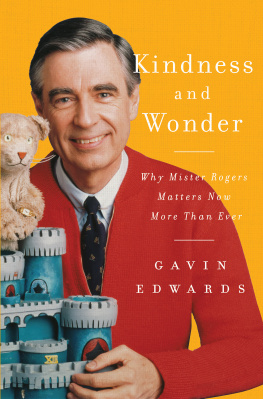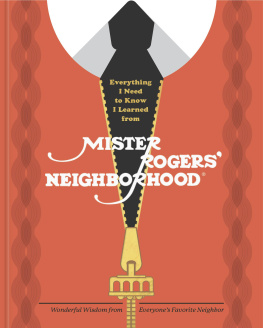
The World of Mister Rogers Neighborhood
Unlike many childrens television shows, Mister Rogers Neighborhood did more than simply entertain or occupy childrens attention. The show educated them in the affective domain, encouraging such things as appreciation for difference, collaboration, self-expression, and self-worth. It also introduced them to the areas of culture, art, and music through guests, trips, art objects and processes, and demonstrations, making these accessible and meaningful in a way that a child could understand. While the educational content of childrens television programming has improved greatly since the late 1960s, no other childrens program has ever attempted such a mix of high art, low art, folk art, industrial production, learning in the affective and social domains, and more, all with a whimsical sense of humor, insight, and a level of interconnected detail unmatched by any other childrens television program. This book illuminates and examines the world of Mister Rogers Neighborhood through world design, narrative, genre, form, content, authorship, reception, and more.
Mark J.P. Wolf is a Full Professor of the Communication Department at Concordia University, Wisconsin. His books include Abstracting Reality, The Medium of the Video Game, Virtual Morality, The Video Game Explosion, Myst and Riven: The World of the Dni, Before the Crash, Encyclopedia of Video Games, Building Imaginary Worlds, The LEGO Studies Reader, and Video Games Around the World. With Bernard Perron, he is the coeditor of The Video Game Theory Reader 1 and 2, and the Landmark Video Game book series.
Imaginary Worlds
Each volume in the Imaginary Worlds book series addresses a specific imaginary world, examining it in the light of a variety of approaches, including transmedial studies, world design, narrative, genre, form, content, authorship and reception, and its context within the imaginary world tradition. Each volume covers a historically significant imaginary world (in all its manifestations), and collectively the books in this series will produce an intimate examination of the imaginary world tradition, through the concrete details of the famous and influential worlds that have set the course and changed the direction of subcreation as an activity.
The World of Mister Rogers Neighborhood
Mark J.P. Wolf
Forthcoming:
The World of The Walking Dead : Transmedia Horror for the Digital Age
Matthew Freeman
The World of Mister Rogers Neighborhood
Mark J. P. Wolf
First published 2017
by Routledge
711 Third Avenue, New York, NY 10017
and by Routledge
2 Park Square, Milton Park, Abingdon, Oxon OX14 4RN
Routledge is an imprint of the Taylor & Francis Group, an informa business
2017 Taylor & Francis
The right of Mark J.P. Wolf to be identified as the author of this work has been asserted by him in accordance with sections 77 and 78 of the Copyright, Designs and Patents Act 1988.
All rights reserved. No part of this book may be reprinted or reproduced or utilised in any form or by any electronic, mechanical, or other means, now known or hereafter invented, including photocopying and recording, or in any information storage or retrieval system, without permission in writing from the publishers.
Trademark notice : Product or corporate names may be trademarks or registered trademarks, and are used only for identification and explanation without intent to infringe.
Library of Congress Cataloging in Publication Data
Names: Wolf, Mark J. P., author.
Title: The world of Mister Rogers Neighborhood / Mark J.P. Wolf.
Description: New York : Routledge, Taylor & Francis Group, 2017. | Includes bibliographical references.
Identifiers: LCCN 2017014963 | ISBN 9781138088115 (hardback)
Subjects: LCSH: Mister Rogers neighborhood (Television program)
Classification: LCC PN1992.77.M5773 W65 2017 | DDC 791.45/72dc23 LC record available at https://lccn.loc.gov/2017014963
ISBN: 978-1-138-08811-5 (hbk)
ISBN: 978-1-315-11008-0 (ebk)
Typeset in Times New Roman
by Deanta Global Publishing Services, Chennai, India
Contents
I would like to thank Barry Keith Grant, Kristina Stonehill, and Annie Martin for initial encouragement; Brittany Smith at The Fred Rogers Company; reference librarian Christian Himsel; Ryan Pierson for pointing out video interview footage; Frenchy Lunning for an anecdote relating to the show; and Erica Wetter at Routledge and the anonymous reviewers for their enthusiasm for the book. Great thanks must go to Tim Lybarger and his website, The Neighborhood Archive , the best on-line sources for all things Mister Rogers ; while many of the post-hiatus episodes can be watched or purchased on-line, very few of the pre-hiatus shows are available, and I am in great debt to the hundreds of hours of labor that it must have taken to post the information and screenshots from these episodes on-line (along with the post-hiatus episodes, as well). I also wish to thank Tim for reading and commenting on a draft of this book as well. Finally, I must thank the late Fred Rogers himself, for creating and communicating everything he did. I always held his show in high regard, and the research for this book has raised my estimation of it even more. Also thanks to my wife Diane, and my sons, Michael, Christian, and Francis, with whom I have watched and enjoyed so many episodes of Mister Rogers Neighborhood . And, as always, thanks be to God.
I went into television because I hated it so, and I thought there was some way of using this fabulous instrument to be of nurture to those who would watch and listen.
Fred Rogers
In the realm of childrens television, Mister Rogers Neighborhood (19682001) was a unique program, and one which will never be duplicated. From the very start, Rogers had a new vision of what childrens television could and should be, one which he developed and perfected over the years on the air. While the show may seem simplistic at first glance, repeated viewings of the program reveal an underlying complexity that one might not expect initially, including a carefully balanced and diverse set of characters and experiences, and the most elaborate imaginary world to appear in childrens television, the ontology, geography, and rules of which extend beyond that of the mundane world. Though Fred Rogers slow pace and clear manner of speech directed at young children have become the target of parody and are immediately evident on the show, a closer look reveals that, unlike many childrens shows, Rogers program neither condescended nor pandered to children, nor did he simplify things beyond what was necessary. He respected children and introduced them to a wide range of cultures and ideas (particularly in the area of music, Rogers own specialty and one of his degree areas), in a style of presentation ranging from serious to surreal; the bizarre juxtapositions and weird situations occurring in some of the shows were on a par with anything Twin Peaks (19901) or Medium (200511) could dish up, but without being dark or gruesome, and the fact that they werent makes them easier to overlook. The imaginary world of the program also grew and expanded over the years, and its level of complexity is also greater than what many viewers might suspect. Whimsical and wildly creative, Rogers nonetheless was always calm, composed, and attentive to his audience, and few television personalities have inspired parasocial relationships with their viewers in such numbers or intensity.






